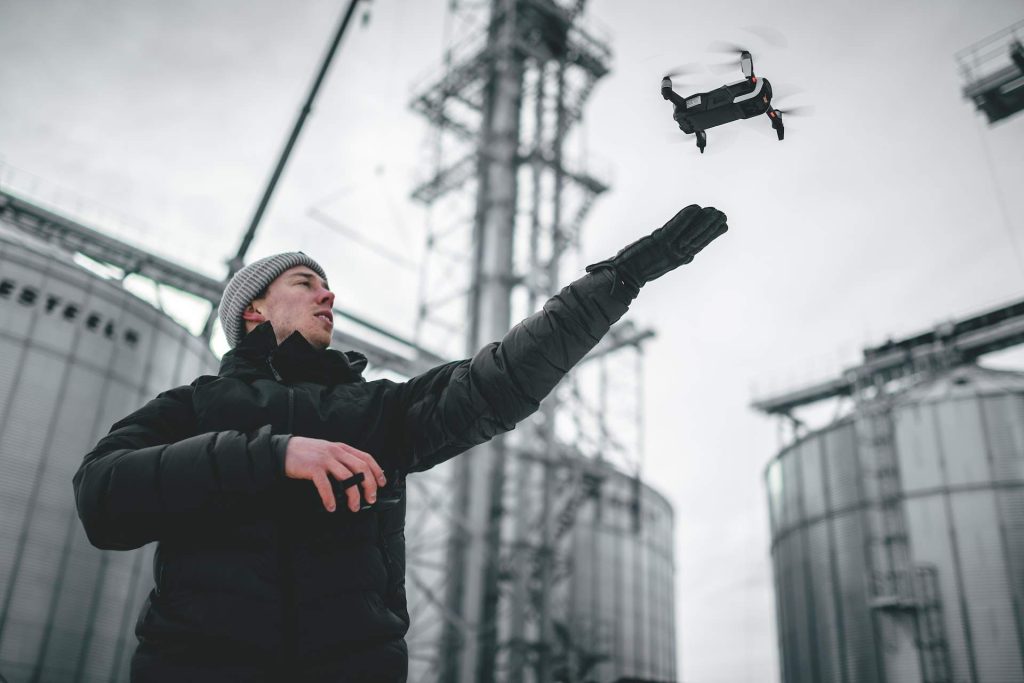How Big Are Drones in the last decade, drone technology has advanced significantly, making these flying machines affordable and increasingly common in various settings. The surge in drone popularity means there’s a wide range of options available, catering to diverse needs.
However, different drones serve different purposes, requiring thorough research to find the right fit. In this article, we’ll provide a straightforward and practical classification of drone types based on specific parameters.

What is the Size of Drones?
Initially, drones might appear small and adorable, but their actual sizes can be quite substantial. On average, drones feature a wingspan of 1 to 2 meters, with certain models reaching up to 5 meters. Additionally, drones tend to carry significant weight, averaging around 6 pounds.
Drones, aren’t they fascinating?
You’re probably already nodding in agreement. While we might not have exact statistics, the consensus is clear: Drones are undeniably impressive. Yet, there’s a distinction between acknowledging their coolness and considering a purchase. If you’re contemplating integrating drones into your life, keep reading for valuable insights.
What is a drone?
A “drone” stands for an unmanned aerial vehicle, a machine capable of flight without human piloting. It navigates via software programming or remote control.
But let’s delve deeper into the terminology:
- RPA or RPAS pertains to Remotely Piloted Aircraft and Systems, representing the remote control of an aircraft.
- “Drone,” the prevalent term, signifies unmanned aircraft.
- UAV or UAS, abbreviated Unmanned Aerial Vehicle and System, highlights the absence of a physical pilot on board.
What are the different types of drones and their uses?
Drones come in an array of sizes, capabilities, and models, ranging from mini recreational drones to sophisticated surveillance variants. Rather than overwhelming you with a flood of new information, we’ve opted to categorize drones into distinct groups for better clarity.
Types of Drones Based on Wing Configuration:
Let’s delve into the four primary drone types categorized by their wing configuration. We’ll explore their applications, advantages, and disadvantages:
| Drone type | Advantage | Disadvantage | Use |
|---|---|---|---|
| Multi-rotor drones | Easy to control and maneuver VTOL and hover flight Often lower price Portability | Limited flying time Small payload capabilities Less stability in the wind Lower flight speeds | Aerial photography Aerial inspection Landing surveying Agriculture |
| Fixed-wing drones | Longer flight time Can carry a heavier payload Greater stability in the wind Higher flight speeds | More training needed No VTOL/hover Expensive Difficult to land, more places needed | Aerial mapping Utility inspection Surveillance Agriculture |
| Single-rotor helicopter drones | VTOL and hover flight Long endurance (with gas power) Heavier payload capability | More dangerous Harder to fly, more training needed Expensive | Aerial LiDAR laser scanning |
| Fixed-wing hybrid VTOL drones | VTOL and hover Long-endurance flight Fast speed Heavier payload capability | More training needed Expensive | Aerial mapping Utility inspection Surveillance Agriculture Search and rescue |
Types Of Drone
Among drone options, we have the Small Drones—compact enough to slip into a backpack, ideal for newcomers. Then, the Medium-sized Drones strike a balance between the small and large variants, both in terms of size and cost. Lastly, Large Drones surpass their medium counterparts, offering an array of features that outshine other drone types.
Here is a detailed note on the size of these types of drones:
Small Drones
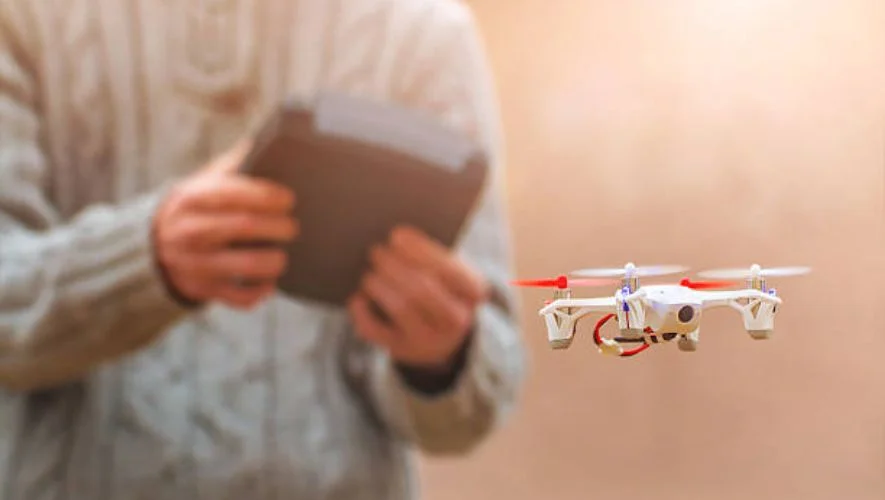
Small Drones typically measure under 15 inches and cater to consumer and hobbyist needs. Characterized by their lightweight design, these drones offer portability, making them perfect for on-the-go adventures.
Despite their compact size, they come with limited range and battery life. Yet, they excel at indoor and confined space flights. Notable examples of small drones include the DJI Mavic Mini and the Parrot Anafi, showcasing the capabilities of these mini marvels.
Medium-sized Drones
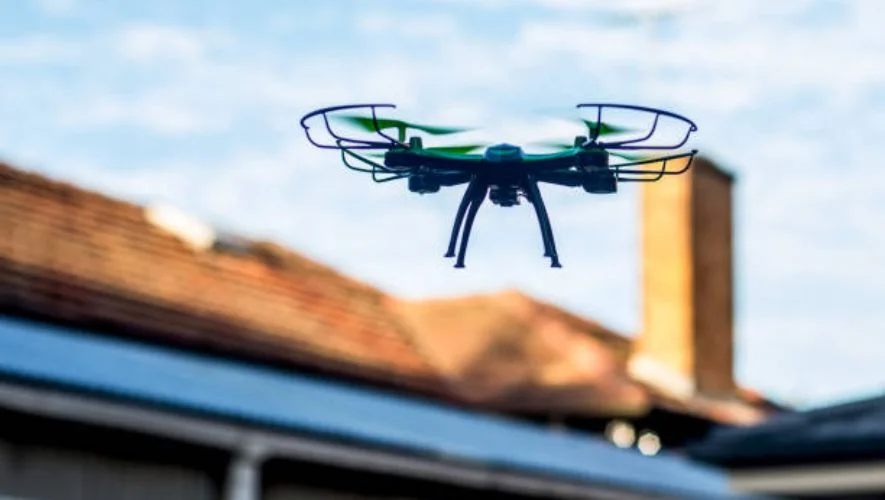
Medium-sized Drones span from 15 inches to 5 feet, finding their place in commercial and professional domains. These drones pack enhanced capabilities, making them a go-to for various applications.
While larger and more adept than their smaller counterparts, medium-sized drones remain reasonably portable, fitting into a backpack or suitcase with ease.
With extended range and battery life, they excel compared to small drones. However, they might be pricier and less agile. Noteworthy medium-sized models encompass the DJI Phantom 4 and the Yuneec Typhoon H, showcasing their versatile prowess.
Large Drones
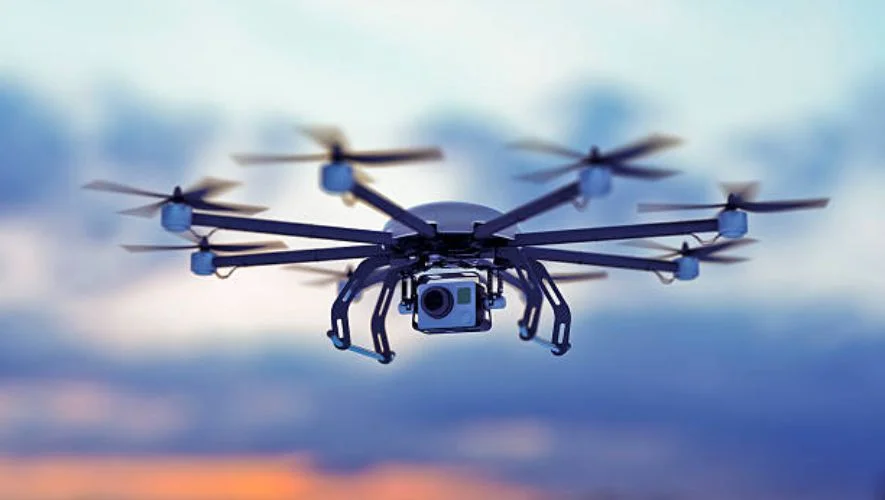
Large Drones command a size exceeding 5 feet and find their niche in industrial and military sectors. These drones, distinguished by their substantial dimensions, pack a potent punch, catering to specialized applications.
Set apart by their impressive size and power, large drones offer prolonged flight times and cover extensive distances. However, their agility might be compromised, necessitating more operational space.
While they provide remarkable capabilities, large drones can be pricier and more challenging to transport. Notable examples of large drones include the DJI Matrice 600 and the General Atomics MQ-9 Reaper, symbolizing their significance in diverse domains.
Types Of Military Drones

A drone is a flying vehicle that is controlled remotely by a pilot. The drone can be controlled either by a person or by artificial intelligence (AI). Drones are used in the military by countries to scout enemy territory and attack enemy targets.
There are several different types of military drones:
- Aerial Drones: These take to the skies for various purposes, including reconnaissance and combat missions.
- Ground Drones (UAVs): Operating on land, these drones are versatile tools used for tasks such as surveillance and transportation.
- Unmanned Underwater Vehicles (UUVs): Designed for underwater exploration, these drones offer crucial insights into aquatic environments.
- Reconnaissance Drones: Focused on intelligence gathering, these drones provide critical information for military strategies.
- Combat Drones: Engaging in warfare, these drones play active roles in various military operations.
- Surveillance Drones: Dedicated to monitoring and observing, these drones maintain vigilant watch over areas of interest.
Aerial Drones:
Aerial Drones, or unmanned aerial vehicles (UAVs), navigate the skies. They span a spectrum of sizes, from tiny consumer drones that fit in your hand to industrial giants measuring several feet in dimensions.
Consider the size of an aerial drone when selecting the right fit. Size influences capabilities and performance. Smaller drones excel in portability and maneuverability but might have constraints on range and battery life. Conversely, larger drones boast extended flight durations and broader coverage, yet may sacrifice agility and demand more operational space.
Ground Drones (UAVs):
Ground drones, or unmanned ground vehicles (UGVs), traverse the land. Their sizes vary, ranging from compact models easily carried by an individual to more substantial units resembling small cars.
When choosing a ground drone, size matters. It shapes the drone’s potential and performance. Compact ground drones prioritize portability and ease of maneuvering, though their range and battery life might be limited. Larger counterparts cover greater distances, and bear heavier loads, but might trade agility for enhanced capabilities and require more operating space.
Unmanned Underwater Vehicles (UUVs):
Unmanned Underwater Vehicles (UUVs) operate beneath the waves. They encompass a range of sizes, from compact units easily carried by an individual to larger models akin to miniature submarines.
The size of a UUV significantly influences its capabilities and performance. Smaller UUVs prioritize portability and maneuverability, although they might have limited range and battery life. In contrast, larger UUVs excel in covering greater distances and bearing larger payloads, though they might trade some agility for enhanced capacity and require more operational space.
Reconnaissance Drones:
Reconnaissance Drones, also known as military surveillance drones, specialize in intelligence gathering. These drones come in diverse sizes, from compact models conveniently carried by a single person to larger versions resembling small aircraft.
Size plays a pivotal role when selecting a reconnaissance drone. It shapes the drone’s potential and performance. Smaller models offer enhanced portability and maneuverability, yet might have constraints on range and battery life.
Combat Drones:
Combat Drones, recognized as military attack drones, serve in military endeavors like targeted strikes. They span various sizes, from compact models easily carried by an individual to larger versions akin to small aircraft.
The size of a combat drone significantly impacts its capabilities and performance. Smaller units emphasize portability and maneuverability but may feature limitations in range and payload capacity.
Surveillance Drones:
Surveillance Drones, also known as surveillance aircraft or unmanned aircraft systems (UAS), focus on monitoring and tracking. These drones come in an array of sizes, from compact models conveniently carried by a single person to larger versions akin to small aircraft.
When choosing a surveillance drone, size plays a pivotal role. It influences the drone’s capabilities and performance.
How Big Аre Drones
Large drones, akin to smaller aircraft, find prominence in military contexts like surveillance and strategic planning. Incorporating cutting-edge technology, they’re supplanting fighter jets, enabling swift enemy detection and combat readiness. Beyond defense, they serve civil purposes, from drone deliveries to filmmaking.
Drone Categories by Payload Capacity: A Weighty Matter
A drone’s lifting capability hinges on motor power and propeller-generated lift under standard weather conditions. Here, we’ll categorize UAVs into four classes based on their payload-carrying capacity.
| Drone type | Weidht | Payload capacity | Use |
|---|---|---|---|
| Featherweight drones | Less than 11 grams (0.011 kg) | 4 grams to 100 grams (0.004 to 0.1 kg) | Military surveillance |
| Lightweight drones | 200-1000 g (0.2-1 kg) | 150-270 g (0.15-0.27 kg) | Recreation and photography |
| Middleweight drones | 1-600 kg (2.20-1323 lb) | 400-1460 grams (0.4-1.46 kg) | Professional applications Aerial photography |
| Heavy-lift drones | More than 160 kg | More than1.000 kg | Enemy detection and combat capabilities Civil applications such as drone deliveries or filmmaking |
Featherweight Drones: The Nano Explorers
Dubbed nanoscale drones, these featherweights tip the scales at a mere 11 grams (0.011 kg). Their carrying capacity spans 4 to 100 grams (0.004 to 0.1 kg).
Lightweight Drones: Mini Marvels
Lightweight drones, akin to minis, boast an average weight of 200 to 1000 g (0.2 to 1 kg). Their payload prowess hovers between 150 to 270 g (0.15 to 0.27 kg).
Middleweight Drones: Straddling the Midrange
Middleweight drones, weighing 1 to 600 kg (2.20 to 1323 lb), bridge the gap. Split into commercial and military categories, they offer versatile applications.
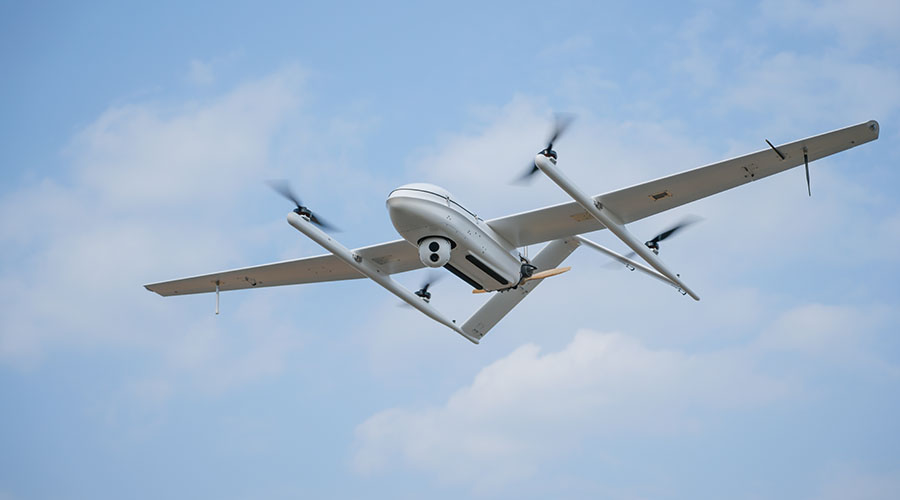
Consumer and Commercial Mid-Weight Drones: Carrying the Load
In the consumer and commercial realm, mid-weight drones shoulder payloads averaging 400 to 1460 grams (0.4 to 1.46 kg). The JOUAV CW-15 stands out, capably accommodating an impressive 3 kg of diverse payloads.
Military Mid-Weight Drones: Handling Precision Payloads
Military mid-weight drones bear loads between 40 kg (88 lb) and 150 kg (331 lb), catering to strategic needs.
Heavy Lift Drones: Powerhouses of Performance
Heavy lift drones, primarily for military and limited delivery, boast substantial dimensions. Weighing over 160 kg, some exceed 1,000 kg. Their payload prowess escalates, reaching 550 kg and beyond, underlining their robust capacity.
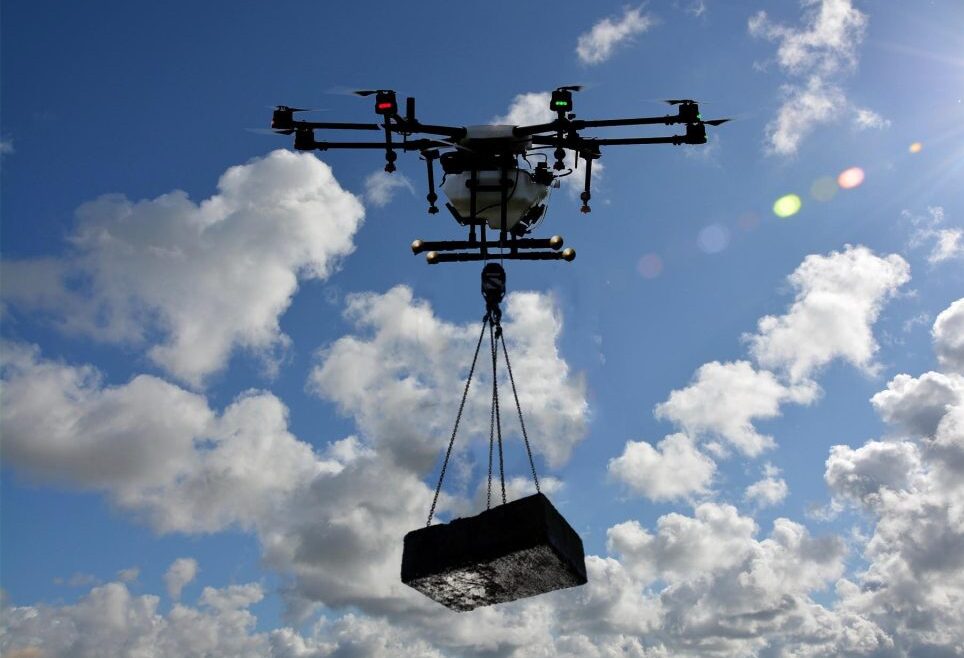
Types of drones according to drone range
According to the range, UAVs can be classified into very close range, close range, short range, mid-range, and long range.
| Drone range | Flight distance | Flight time | Use |
|---|---|---|---|
| Very close-range drones | 5 km | 1 hour | Recreation |
| Close-range drones | up to 50 km | 1-6 hours | Military surveillance Aerial photography |
| Short-range drones | up to 150 km | 8-12 hours | Large-scale surveillance Mapping and surveying Utility inspection |
| Mid-range drones | 644 km | 24 hours | Military combat and surveillance |
| Long-range drones | More than 644 km | More than 24 hours | Military surveillance and espionage Weather tracking Geographic mapping |
Very Close-Range Drones: Recreational Flight
These drones cover 5 km from the controller and offer around 1 hour of flight time, perfect for leisure activities.
Close-Range Drones: Tactical Observation
Capable of flying up to 50 km, these drones stay airborne for 1-6 hours, often utilized for military surveillance due to their higher flight altitude.
Short-Range Drones: Extended Scope
Flying up to 150 km, these drones operate for 8-12 hours with powerful batteries, serving both combat and surveillance functions.
Mid-Range Drones: Extended Exploration
Capable of 400 miles (644 km) and flying at altitudes of 12,000 to 30,000 feet for over 24 hours, these drones are commonly employed in combat and surveillance.
Long-Range Drones: Unprecedented Reach
These advanced drones can cover over 400 miles (644 km) without signal loss, primarily for military surveillance, but also utilized in weather tracking, geology, and geographical mapping.
Types of Drones by Power Source
Drones’ classification extends to their power sources—battery or fuel—essentially shaping their capabilities.
| Power source | Pros | Cons |
|---|---|---|
| Battery-powered drones | Lightweight Ability to store decent amounts of energy High discharge rates | Short lifespan Mistreat them and they can start a fire Use up energy fast |
| Gasoline-powered drones | Potentially dangerous as they carry highly combustible fuels More noise than a battery-operated drone Large size | No need for expensive battery backup and charging stations No need to wait for batteries to recharge Higher flight speed Easily carry heavier payloads Longer flight time Smooth and stable flight |
| Hydrogen fuel cell drones | Renewable and environmentally friendly Resourceful Higher energy density than batteries Longer flight time Refuels in just minutes Works at low temperatures | Generate a lot of heat Currently very poor in terms of efficiency |
| Solar drones | Reduce operating costs Increase operating hours Lightweight | Limited flight time |
Battery: Common Power Source
Most drones rely on batteries, with lithium polymer (LiPo), nickel-metal hydride (NiMH), and nickel-cadmium (NiCd) batteries being prevalent options.
Gasoline: Fueling Larger Drones
Gasoline powers larger drones due to its lightness and cost-effectiveness, resulting in extended flight times and greater payload capacities.
Hydrogen: Elevated Efficiency
Hydrogen-powered drones excel at high altitudes compared to internal combustion engine alternatives, offering efficiency and safety with minimal noise and emissions.
An innovative example is the CW-25H (DJ25), a hydrogen-powered drone developed by JOUAV and Doosan Innovation, earning the CES 2022 Innovation Award. It can transport up to 4 kg payloads.
Frequently Asked Questions (How Big Are Drones)
What Are The Sizes Of Drones?
Drones, also known as UAVs, exhibit a diverse range of sizes. From palm-sized models to aircraft-sized giants, their dimensions depend on purpose, payload, and propulsion. Recreational drones for leisure and media tend to be compact, while commercial drones for tasks like surveillance, mapping, and delivery often boast larger frames.
Examples of Drone Sizes:
- Small Drones: Compact, handheld, perfect for beginners.
- Medium-sized Drones: Between handheld and airplane-sized, suitable for various applications.
- Large Drones: Comparable to smaller aircraft, mainly for military and industrial use.
Exploring Drone Sizes
Drones come in various sizes to cater to different needs:
- Mini Drones: Under 250 grams, perfect for indoor flying and beginners.
- Mid-Size Drones: 250 grams to 2 kilograms, ideal for outdoor flying, photography, and longer flight times.
- Large Drones: Over 2 kilograms, equipped with advanced features for professional tasks like surveying and mapping.
- Very Large Drones: Over 25 kilograms, used for specialized purposes like long-range surveillance and military operations.
What Are The 4 Main Types Of Drones?
Drones can be classified based on their intended use. Here are the four main types:
- Recreational Drones: Designed for personal enjoyment, these lightweight drones are easy to fly and often used for casual photography and fun activities.
- Commercial Drones: Used for business or professional purposes, such as surveying, mapping, inspection, or delivery. They are typically more advanced and may have specialized sensors or payloads for specific tasks.
- Military Drones: Used by the military for surveillance, reconnaissance, and other operations. They are equipped with advanced sensors and weapons for diverse environments.
- Agricultural Drones: Utilized in agriculture to monitor crops, apply fertilizers, and pesticides, and perform tasks. They have specialized sensors and the capacity to carry payloads like seeds or chemicals.
What Is The Biggest Size Of A Drone?
Presently, one of the largest operational drones is the General Atomics MQ-9 Reaper, also called the Predator B. Utilized by the US military and other nations, it boasts a massive wingspan of 66 feet (20 meters) and a maximum takeoff weight of 10,000 pounds (4,536 kilograms).
Capable of soaring to altitudes of 50,000 feet (15,000 meters) and maintaining flight for up to 27 hours, the General Atomics MQ-9 Reaper is remarkable in its capabilities.
Other sizable drones include the Northrop Grumman RQ-4 Global Hawk, featuring a wingspan of 116.2 feet (35.4 meters) and a maximum takeoff weight of 32,250 pounds (14,640 kilograms), and the Airbus Defense and Space HAPS, boasting a wingspan of 262 feet (80 meters) and a maximum takeoff weight of 2,000 kilograms.
It’s important to bear in mind that regulations governing drone size and use vary across different countries and regions, potentially imposing limitations on drone dimensions for specific areas or purposes.
How Large Are Commercial Drones?
Commercial Drones are often thought of as being small and compact devices. However, several commercial drones are quite large. This is because they need to be able to carry a payload and/or have enough capacity for their intended purpose.
Commercial drone sizes can vary based on their intended purpose and payload capacity. Some remain compact and lightweight, while others boast larger frames to accommodate heavier payloads or extended flight durations. Here are a few examples of commercial drones and their approximate sizes:
- DJI Phantom 4: A mid-size drone with a wingspan of about 15 inches (38 cm) and a weight of about 3 pounds (1.4 kg). It is favored for capturing photos and videos and is popular among professionals and enthusiasts.
- DJI Matrice 600: A large drone with a wingspan of about 60 inches (152 cm) and a weight of about 18 pounds (8 kg). It is utilized for professional applications like surveying, mapping, and inspection, and is capable of carrying various payloads.
- DJI Matrice 100: A mid-size drone with a wingspan of about 33 inches (84 cm) and a weight of about 6.5 pounds (3 kg). It is employed for professional purposes such as research, inspection, and mapping, and can be equipped with diverse sensors and payloads.
- DJI Phantom 3 Professional: A mid-size drone with a wingspan of about 15 inches (38 cm) and a weight of about 2.8 pounds (1.3 kg). It is renowned for capturing photos and videos and is favored by professionals and enthusiasts.
- DJI Mavic 2 Pro: A mid-size drone with a wingspan of about 13.5 inches (34 cm) and a weight of about 2 pounds (0.9 kg). It excels in capturing photos and videos and is popular among professionals and enthusiasts.
Conclusion
Drones are small enough to fit in the palm of your hand, while others are much larger and can be as big as a traditional airplane. The size of a drone is determined by several factors, including its intended use, payload capacity, and the type of propulsion system it uses.
Hopefully, you’ve gained valuable insights from this guide on the various size categories of drones and their corresponding classifications. Choosing a drone that aligns with your needs and expertise is crucial.
Whether you use this information to narrow down your drone selection or for other purposes, our aim is for this guide to be informative and useful to you. Best of luck in your pursuit of the perfect drone. The next time someone asks, “How big are drones?” you’ll have the answer at your fingertips!

